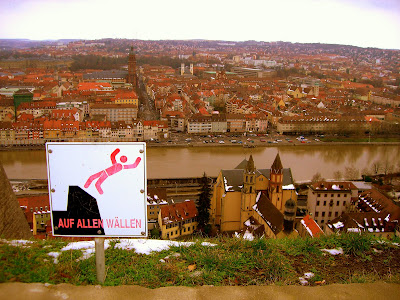Fortress Marienberg after a Strong Suffolk Ale
 The town of Wuerzburg lies one hour west of Bamberg. The river in the above photo is in fact the Main river (pronounced "Mine!"), which confluences with the Regnitz in Bamberg. I spent an evening and a day here in Wuerzburg with friends. The evening was a bit of a pub crawl, starting at a bar serving over one hundred beers.
The town of Wuerzburg lies one hour west of Bamberg. The river in the above photo is in fact the Main river (pronounced "Mine!"), which confluences with the Regnitz in Bamberg. I spent an evening and a day here in Wuerzburg with friends. The evening was a bit of a pub crawl, starting at a bar serving over one hundred beers.Bavarians are very proud of their wonderful beers, and for that reason, it can be very difficult to track down imported or even non-regional beer. Strong Suffolk Vintage Ale is a luxurious, complex blend of a two year-old, oak barrel aged ale (12% ABV) and a freshly brewed dark ale (5%). And we were walking toward a pub that offered this speciality, this nectar of the gods, as if we Bierwolves of Bamberg were awoken with full moon nigh, and the very tears of Gambrinus lay before us in half liter glassware.
My friend had been describing the beer to me, how he had come to find this wonderment of cellarwork, of plums and wood and raisins and spice, of philosophy and prose that left me thinking of nothing other than sitting in a dark english pub and sipping on a fine old beer whilst some laddies play fiddle -n- pan flute in the corner an the salty ol Captain Haddock pulled gently on a pipe, whispering stories of leviathans and sirens to the fearstruck greenhorns.
 We walked right into "Jaegermeister On Tour", comically coloured just like merry ol Halloween in the Great U.S. of Amorica. Police siren lights, slick Brunos with Junkanoo whistles, call and response "Jaeger!" then "Meister!", everyone dancing on tables and the bar, some guy dressed in a deer suit trying to make us take free shots, and music horrible and loud, preventing any conversation whatsoever.
We walked right into "Jaegermeister On Tour", comically coloured just like merry ol Halloween in the Great U.S. of Amorica. Police siren lights, slick Brunos with Junkanoo whistles, call and response "Jaeger!" then "Meister!", everyone dancing on tables and the bar, some guy dressed in a deer suit trying to make us take free shots, and music horrible and loud, preventing any conversation whatsoever.Needless to say, Captain Haddock was nowhere to be found. We sat down and enjoyed our fine beers, and commenced yelling at each other, trying to be heard. What was ammusing to me, was that once the Jaeger troopers left, the music quieted down and was suddenly likable, the other customers sat down and were mellow, we could hear each other and you could barely tell that such a storm of pop marketing had come and gone.
 The day after the Strong Suffolk Ale and some of his freinds, we toured the Fortress Marienburg. This is a castle that saw battles. The hill on which it stands has been home to some version of fortification since the 8th century. Over the centuries, it was taken and reclaimed and fortified and remodeled and so on, ending in a fortification with multiple defensive wall structures and an intimidating presence.
The day after the Strong Suffolk Ale and some of his freinds, we toured the Fortress Marienburg. This is a castle that saw battles. The hill on which it stands has been home to some version of fortification since the 8th century. Over the centuries, it was taken and reclaimed and fortified and remodeled and so on, ending in a fortification with multiple defensive wall structures and an intimidating presence. The keep, the tower in the photo, originally had no door where the two tourists peer in. The door was build more recently. The door enters a chamber, that used to be accessed only from a hole in the ceiling. This is where prisoners were lowered into the "Room of Fear", as it was known. Nasty times, those middle ages.
The keep, the tower in the photo, originally had no door where the two tourists peer in. The door was build more recently. The door enters a chamber, that used to be accessed only from a hole in the ceiling. This is where prisoners were lowered into the "Room of Fear", as it was known. Nasty times, those middle ages. An invasion force of over 15,000 peasants tried to capture the fortress in 1525, but were stopped by the steep defenses. When their leader went looking for bigger cannons, the bishop's formally trained army rode out and massacred the leaderless farmers army.
An invasion force of over 15,000 peasants tried to capture the fortress in 1525, but were stopped by the steep defenses. When their leader went looking for bigger cannons, the bishop's formally trained army rode out and massacred the leaderless farmers army.One hundred years later, during the Thirty Years War, Gustav Adolf of Sweden conquered the castle as his army swept southwards towards Munich. Napoleon armies captured the castle in the early part of the 1800s, as did the Americans in WWII.


















